Oat Flour Bread

Ingredients:
| Name | Metric | US | TIP | |
|---|---|---|---|---|
| Oat Flour | 300 gr | 3 cups | ||
| Psyllium Husk | 26 gr | 1/3 cup | ||
| Water | 360 ml | 1 1/4 cups | ||
| Baking powder | 15 gr | 2 tsp | ||
| Sea salt | 6 gr | 1 tsp |
Optional Ingredients :
| 30 gr / 2 tbsp Mixed Seeds (Sunflower Seeds, Pumpkin Seeds, Hulled Hemp Seeds) | |
| 2 tbsp / 10 gr Rolled Oats as a topping |
Equipment:
| Hand Mixer / Stand Mixer fitted with a dough hook | |
| Loaf pan 8.5in x 4.5in / 21.5cm x 11.5cm |
Steps:
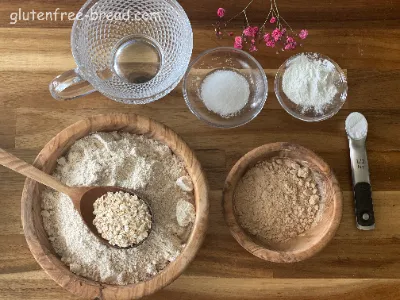
Step 1

Step 2
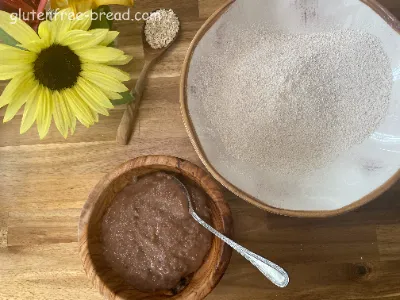
Step 3
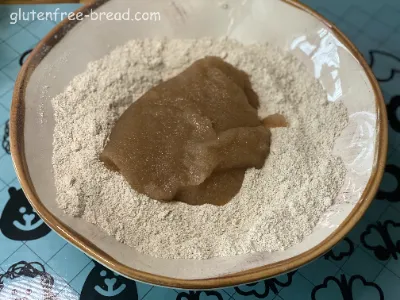
Step 4

Step 5
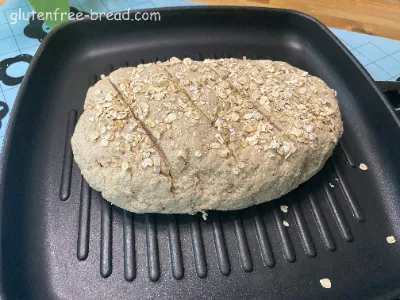
Step 6
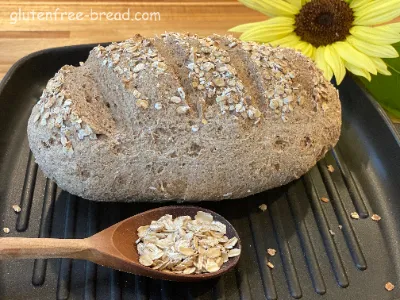
Step 7

Step 8
Notes:

Oat Flour Bread
Sifting oat flour, salt, and baking powder serves several purposes in baking:
Breaking up clumps: Oat flour, like many other flours, can clump together during storage. Sifting breaks up these clumps, ensuring a smoother and more consistent texture in your baked goods.
Incorporating air: Sifting aerates the flour mixture by introducing air into it. This helps to lighten the mixture, which can contribute to a lighter texture in your final baked product.
Mixing evenly: It ensures that the salt and baking powder are evenly distributed throughout the flour. This is crucial because both ingredients play key roles in the chemical reactions that occur during baking (salt for flavor enhancement and baking powder for leavening).
To sift these ingredients, you can use a fine mesh sieve or a flour sifter. Simply place the sieve over a bowl, add the oat flour, salt, and baking powder to the sieve, and gently tap or shake it to sift the mixture into the bowl below. If there are any larger particles left in the sieve after sifting, you can discard them or break them up and sift again.
Incorporating oat flour into psyllium gel by hand can be a bit challenging due to the unique properties of oat flour and the nature of psyllium gel. Here are some considerations and tips to make the process easier:
Psyllium Gel Consistency: Psyllium husk absorbs water and forms a gel-like consistency when mixed with water. This gel can be sticky and dense, making it a bit difficult to blend in dry ingredients like oat flour evenly.
Kneading Technique: Use a folding and pressing motion rather than traditional kneading when incorporating oat flour into psyllium gel. This helps distribute the flour more evenly without creating pockets of dry flour.
Patience: It may take a bit more time and effort compared to traditional dough kneading. Be patient and continue to work the mixture until the oat flour is fully integrated.
Adjusting Consistency: If the mixture becomes too dry or too sticky, adjust by adding a little water or oat flour accordingly. The goal is to achieve a dough-like consistency that holds together well.
Use of Tools: Consider using a spatula or dough scraper to help fold and mix the ingredients effectively. This can prevent sticking and make the process smoother.
By following these tips, you can make the process of incorporating oat flour into psyllium gel kneading by hand more manageable and achieve a well-mixed dough for your baking needs.
Oat Flour Bread additional information:
The final result of your oat flour psyllium bread can be influenced by the brand of oat flour and its fineness:
Texture: Different brands of oat flour can have varying textures depending on how finely the oats are ground. Finer oat flour tends to produce a smoother and more cohesive dough, whereas coarser oat flour may result in a bread with a more rustic texture.
Absorption Rate: The fineness of the oat flour can affect how much liquid it absorbs. Finer oat flour may require slightly less liquid compared to coarser oat flour. This can impact the hydration level of your dough and ultimately the texture of the bread.
Rise and Structure: The particle size of oat flour can also affect the rise and structure of your bread. Finer oat flour may contribute to a more even rise and a finer crumb structure, whereas coarser oat flour might result in a denser crumb.
Flavor: While the flavor of oat flour itself is generally mild, the texture and mouthfeel can vary depending on how finely it's ground. Finer oat flour can contribute to a smoother, more uniform taste experience.
Psyllium husk is a key ingredient in many gluten-free baking recipes, especially those using alternative flours like oat flour. Here's how psyllium husk can influence your recipe:
Binding and Texture: Psyllium husk is a hydrophilic fiber, meaning it absorbs water and forms a gel-like substance when mixed with liquids. This gel helps bind the ingredients together, which is crucial in gluten-free baking where gluten (a protein responsible for elasticity and structure in traditional bread) is absent. It improves the overall texture of the bread by providing elasticity and moisture retention.
Structure and Rise: The gel formed by psyllium husk also helps trap air bubbles, contributing to the rise of the bread. This is important for achieving a light and airy texture, similar to that of wheat-based bread.
Hydration: Psyllium husk absorbs a significant amount of water, so it's important to use the correct ratio of psyllium husk to liquid in your recipe. If you use too little psyllium husk, the bread may be crumbly and dry. Conversely, too much psyllium husk can make the bread overly dense and gummy.
Flavor and Nutritional Benefits: Psyllium husk itself has a neutral flavor, so it won't significantly impact the taste of your bread. However, it adds dietary fiber to your recipe, which can be beneficial for digestive health and overall nutrition.
Baking Time and Temperature: Psyllium husk can affect baking times and temperatures. Since it retains moisture well, your bread may need slightly longer baking times compared to recipes without psyllium husk. Additionally, it's important to monitor the crust to prevent over-browning.
Psyllium husk can potentially change the color of bread, especially if used in larger quantities or if the bread is baked for an extended period. Here are some factors to consider and tips to avoid or minimize any color change:
Quantity Used: Psyllium husk typically has a light beige to brownish color. Using too much psyllium husk relative to the amount of other ingredients in your recipe can darken the color of the bread.
Baking Time and Temperature: If the bread is baked at too high a temperature or for too long, the psyllium husk can darken. This is because prolonged exposure to heat can cause the natural color of the psyllium husk to intensify and potentially affect the overall color of the bread.
Covering During Baking: To prevent excessive browning, you can cover the bread with aluminum foil during the latter part of baking. This helps shield the bread from direct heat and reduces the likelihood of the psyllium husk affecting the color.
Use Light-Colored Psyllium Husk: Some brands offer lighter-colored psyllium husk, which can help minimize any noticeable color change in your bread. Look for psyllium husk that is lighter in color if you are concerned about the appearance of your baked goods.
Recipe Adjustments: If you notice that your bread is consistently darker than desired, consider adjusting the amount of psyllium husk used in your recipe. Start with the recommended amount and adjust gradually until you achieve the desired texture and structure without compromising the appearance.
Here are the general nutritional benefits and values of Oat Flour Bread:
Oat Flour: Oat flour is a nutritious alternative to wheat flour, especially in gluten-free baking. It provides:
- Dietary Fiber: Oats are rich in soluble fiber, particularly beta-glucan, which helps lower cholesterol levels and improve heart health.
- Protein: Oats contain more protein than most other grains, providing essential amino acids.
- Vitamins and Minerals: Oats are a good source of several vitamins and minerals, including manganese, phosphorus, magnesium, copper, iron, zinc, folate, and B vitamins.
Psyllium Husk: Psyllium husk adds additional fiber to the bread:
- Soluble Fiber: Psyllium husk is primarily soluble fiber, which helps regulate digestion, improve bowel movements, and can aid in managing cholesterol levels.
Overall Benefits:
- Low Glycemic Index: Oats and psyllium husk have a low glycemic index, meaning they cause a slower and more sustained increase in blood sugar levels compared to refined grains.
- Gluten-Free: If made with certified gluten-free oat flour, this bread is suitable for individuals with gluten intolerance or celiac disease.
- Satiety: The combination of fiber and protein from oat flour and psyllium husk can help you feel full and satisfied.







